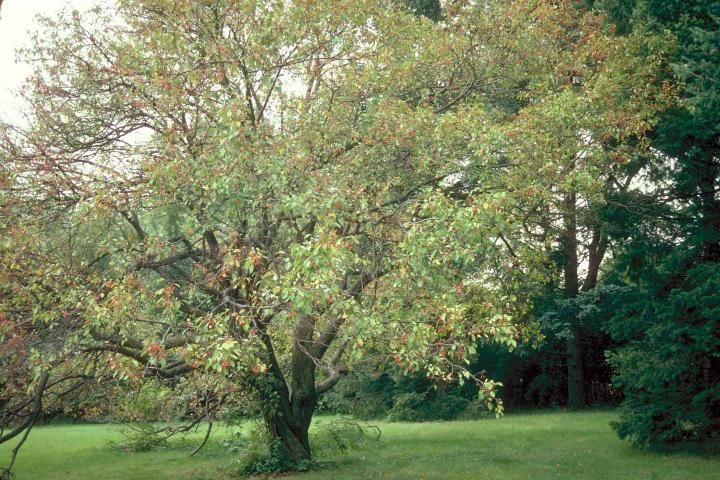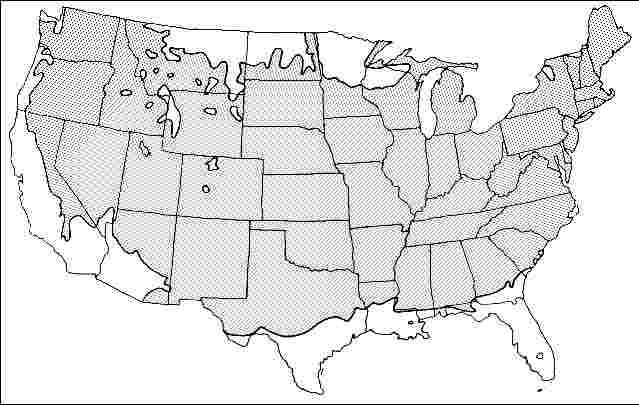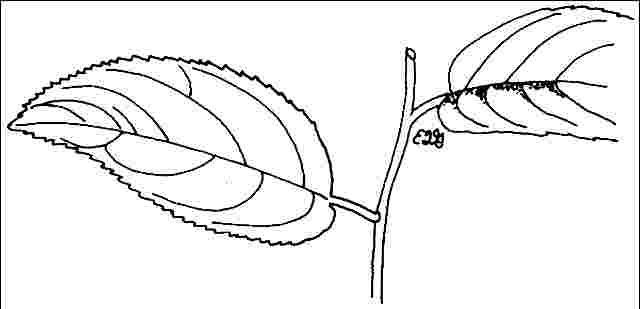Introduction
A hybrid of Malus baccata and Malus seiboldii, redbud crabapple grows at a moderate rate to 25 feet tall and 15 feet wide (can grow 30 feet wide), creating a dense, pyramidal form with weeping branch tips. True to its name, the blossoms of redbud crabapple start out as red buds in spring which open to soft pink flowers, eventually fading to white. These blooms are delightfully fragrant and open in spring before the new leaves appear. The small, shiny, bright orange/red fruits that follow, persist on the tree well into the winter, if not first eaten by birds.

Credit: Ed Gilman, UF/IFAS
General Information
Scientific name: Malus x zumi
Pronunciation: MAY-lus x ZOO-mee
Common name(s): Redbud crabapple, 'Calocarpa' zumi crabapple
Family: Rosaceae
USDA hardiness zones: 4A through 8A (Fig. 2)
Origin: not native to North America
Invasive potential: little invasive potential
Uses: espalier; street without sidewalk; tree lawn 3-4 feet wide; tree lawn 4-6 feet wide; tree lawn > 6 ft wide; deck or patio; trained as a standard; container or planter; parking lot island > 200 sq ft; parking lot island 100-200 sq ft; parking lot island < 100 sq ft; highway median
Availability: not native to North America

Description
Height: 20 to 25 feet
Spread: 15 to 30 feet
Crown uniformity: irregular
Crown shape: spreading
Crown density: dense
Growth rate: moderate
Texture: medium
Foliage
Leaf arrangement: alternate (Fig. 3)
Leaf type: simple
Leaf margin: serrate, serrulate, crenate
Leaf shape: elliptic (oval)
Leaf venation: pinnate, brachidodrome
Leaf type and persistence: deciduous
Leaf blade length: 2 to 4 inches
Leaf color: green
Fall color: yellow
Fall characteristic: not showy

Flower
Flower color: white/cream/gray, pink
Flower characteristics: very showy
Fruit
Fruit shape: round
Fruit length: less than .5 inch
Fruit covering: fleshy
Fruit color: red, orange
Fruit characteristics: attracts birds; showy; fruit/leaves not a litter problem
Trunk and Branches
Trunk/bark/branches: branches droop; not showy; typically multi-trunked; thorns
Pruning requirement: needed for strong structure
Breakage: resistant
Current year twig color: brown
Current year twig thickness: thin, medium
Wood specific gravity: unknown
Culture
Light requirement: full sun
Soil tolerances: clay; sand; loam; acidic; alkaline; well-drained; occasionally wet
Drought tolerance: moderate
Aerosol salt tolerance: low
Other
Roots: not a problem
Winter interest: yes
Outstanding tree: yes
Ozone sensitivity: unknown
Verticillium wilt susceptibility: resistant
Pest resistance: resistant to pests/diseases
Use and Management
This has been described as one of the best crabapples for street tree planting. When specifying trees for street or parking lot planting, be sure to order single trunked trees with major branches located as high on the trunk as possible. This will reduce the need to prune off lower limbs to provide clearance for vehicles and pedestrians. However, branches will still need to be removed as the tree grows older due to the slightly drooping habit of the tree. Suckers from the root system may also need to be occasionally removed. Trees planted away from walks and streets can be pruned and trained any way you like. They often look nice with branches left to the ground, forming a solid, thick, mounding shape with age.
Redbud crabapple should be grown in full sun on well-drained, acid soil. They are adapted to a variety of soils, including clays. It is recommended that you purchase trees propagated on their own roots.
Pests
No pests are of major concern. Aphids can usually be found infesting a variety of crabapples, including this one. Control of pests is usually not needed.
Diseases
Although resistant to scab, redbud crabapple is susceptible to fireblight and mildew.